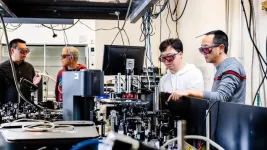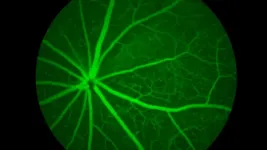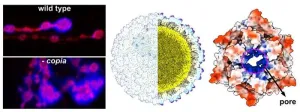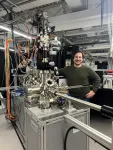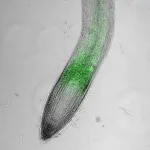(Press-News.org)
Images
A sponge-like implant in mice helped guide a treatment that slowed or stopped a degenerative condition similar to multiple sclerosis in humans. It also gave University of Michigan researchers a first look at how primary progressive multiple sclerosis, the fastest-progressing version of the disease, attacks the central nervous system early on.
If administered early, the nanoparticle-based treatment prevented mice from developing symptoms such as paralysis. If given after the first symptoms emerged, it reduced symptom scores by half compared to untreated mice.
On average, primary progressive multiple sclerosis causes severe disability within 13 years—including balance issues, difficulty walking and vision problems—but this can also happen within two years. Researchers know that immune cells attack the myelin sheath around nerves—a bit like the insulation around an electrical wire—but it's hard to discover the details of how that is happening. Because the attacks occur in the brain and spinal cord, it's not possible to take biopsies from living patients.
"Right now, we simply can't get access to diseased tissue from MS patients in any regular way. Some patients donate brains after death, but at that point the disease has progressed quite far," said Aaron Morris, U-M assistant professor of biomedical engineering and co-corresponding author of the study in the Proceedings of the National Academy of Sciences.
Without an understanding of how the disease works, researchers have been unable to develop effective treatments. Currently, the only FDA-approved drug helps slow disease progression but does not offer full remission. Since it works by damping down the immune system, it also exposes patients to infection.
To help enable better treatments, the research team used a sponge-like implant, previously used to diagnose relapsing MS or discover whether an implanted organ is being rejected. Also known as a scaffold, it is a cylinder of biodegradable polyester, 13 millimeters diameter and 2 millimeters in height, full of small pores where cells can attach.
After implanting the scaffold just under the skin around the shoulder blades, the team induced the MS-like autoimmune condition in half of the mice while the other half served as a healthy comparison. Over several weeks, immune cells attracted to the foreign object grew into the pores, along with other cells. This created an easily biopsied tissue surrogate outside of the central nervous system that provides clues to the disordered immune response in MS.
The team analyzed the tissue from the sponges with single-cell RNA sequencing to discover what individual cells were doing, which helped unravel differences between diseased and healthy tissue. A group of proteins called CC chemokines were particularly overactive in diseased tissue. These proteins call over other cells to fight infection, but when the call is too loud, they trigger the immune cells to attack healthy tissue.
With this information in hand, the researchers developed injectable nanoparticles, just 400 nanometers in diameter, that surround a key CC chemokine and disrupt the misplaced inflammation. This mechanism prevented symptoms from developing when the mice were treated early and reduced their symptoms by more than half if given after onset. A close look at immune cells confirmed less disease activity in nanoparticle-treated mice.
"The scaffold provides an unprecedented ability to track disease dynamics and to investigate the underlying mechanisms, particularly at early stages. Therapies targeting these early mechanisms can halt disease progression before significant tissue damage," said Lonnie Shea, the Steven A. Goldstein Collegiate Professor of Biomedical Engineering and co-corresponding author of the study.
The research is funded by the National Institutes of Health (R00EB028840; 1R01AI155678; 1R01CA243916; R01CA272940; TDE007057), the University of Michigan Biointerfaces Institute and the University of Michigan Precision Health Scholars.
Flow cytometry was conducted at the University of Michigan Flow Cytometry Core and assays were run using the Immune Monitoring Shared Resource. The Advanced Genomics Core provided genomics resources, and the device was studied at the Michigan Center for Materials Characterization.
Shea is a consultant for and has financial interests in Cour Pharmaceuticals, which licensed the nanoparticle technology used in this study with the help of Innovation Partnerships.
Study: Engineered immunological niche directs therapeutic development in models of progressive multiple sclerosis (DOI: 10.1073/pnas.2409852122)
Learn more about the inside-out approach to diagnose disease from Aaron Morris' TED Talk: How your body could become its own diagnostic lab
END
Multiple sclerosis: Cell-catching implant helps identify successful treatment in mice
The implant attracts diseased immune cells, enabling researchers to study and target them with a nanoparticle-based treatment
2025-02-18
ELSE PRESS RELEASES FROM THIS DATE:
Q&A: Is it always ‘us vs them’? Researcher explains why flexibility is key
2025-02-18
UNIVERSITY PARK , Pa. — Urban versus rural. Penn State versus Michigan. Star Wars versus Star Trek. As social beings, humans gravitate toward groups. But sometimes group living can spur an “us versus them” mentality that causes conflict, especially when two groups are competing for the same limited resources, like money or a championship trophy.
In the following Q&A, Anne Pisor, assistant professor of anthropology at Penn State and Social Science Research Institute co-funded faculty member, discussed her recently published paper on the “us versus them” mindset as well as the causes and how to overcome it.
Q: What does your research say about ...
New nanoscale technique unlocks quantum material secrets
2025-02-18
Scientists are racing to develop new materials for quantum technologies in computing and sensing for ultraprecise measurements. For these future technologies to transition from the laboratory to real-world applications, a much deeper understanding is needed of the behavior near surfaces, especially those at interfaces between materials.
Scientists at the U.S. Department of Energy’s (DOE) Argonne National Laboratory have unveiled a new technique that could help advance the development of quantum technology. Their innovation, surface-sensitive spintronic terahertz spectroscopy (SSTS), provides an unprecedented look at how quantum ...
New study uncovers how genes influence retinal aging and brain health
2025-02-18
Vision changes are an inevitable part of aging, but why are some more susceptible to age-related eye diseases and why do some individuals experience more severe decline than others? New research from The Jackson Laboratory (JAX) reveals that genetics play a key role in how the eye ages, with different genetic backgrounds influencing retinal aging in distinct ways.
The study, published in Molecular Neurodegeneration, examined age-related changes in genes and proteins of the retinas of nine strains of mice, ...
‘False’ springs, long summers mean uncertainty for NY grape growers
2025-02-18
CORNELL UNIVERSITY MEDIA RELATIONS OFFICE
FOR RELEASE: Feb. 17, 2025
Kaitlyn Serrao
607-882-1140
kms465@cornell.edu
‘False’ springs, long summers mean uncertainty for NY grape growers
ITHACA, N.Y. – Warmer autumns and more “false” springs are disrupting the signals grapevines rely on to gain cold hardiness for the winter and blossom effectively in the spring, according to new research from Cornell University.
“In New York, we are right at the coldest ...
A treatment-resistant, severe type of asthma successfully modeled in mice
2025-02-18
A better understanding of inflammation and lung immunity over the past two decades has led to new, innovative treatments for asthma, including biologic therapies.
This is especially true for a subtype known as eosinophilic asthma—asthma that’s related to the recruitment and overactivation of white blood cells in the lungs called eosinophils.
However, a different type of asthma called neutrophilic asthma has fewer treatment options and doesn’t respond as well to first line asthma therapy.
As a result, people with this type of asthma, which ...
Cholesterol metabolism byproduct linked to Parkinson’s disease
2025-02-18
Researchers led by Zhentao Zhang at Wuhan University, China have discovered a cholesterol metabolite that plays a critical role in the development of Parkinson’s disease in mice. Published in the open-access journal PLOS Biology on February 18th, the study shows that this metabolite is responsible for the formation of Lewy bodies and the death of dopaminergic neurons in the brain—the two major hallmarks of Parkinson’s disease. Blocking its activity or preventing it from being made by the body could therefore be effective strategies for treating the disease.
Parkinson’s disease develops when the protein alpha-Syn forms clumps of tiny pathological fibers ...
The capsid of the virus-derived retrotransposon Copia, a parasitic genome element, mediates synaptic plasticity at the Drosophila neuromuscular junction
2025-02-18
In your coverage, please use this URL to provide access to the freely available paper in PLOS Biology: https://plos.io/42Ly2Pr
Article title: Capsid transfer of the retrotransposon Copia controls structural synaptic plasticity in Drosophila
Author countries: United States
Funding: This work was supported by NIH Grant R01NS112492 to TT. The funders had no role in study design, data collection and analysis, decision to publish, or preparation of the manuscript. END ...
Sweet molasses feed key to understanding grazing behavior in cattle
2025-02-18
Researchers tempted grazing cattle with sweet molasses feed to discover whether cows would roam far and wide to graze or stick close to the herd, water supplies and feed stations.
The findings by animal scientists at the University of California, Davis, and published in the journal Scientific Reports, offer a low-cost way for ranchers and others to identify the best cows for their landscapes to optimize grazing while meeting the nutritional needs of cattle.
This is the third in a series of papers about research seeking to better understand the grazing personalities of cattle. The first studies ...
Fabio Boschini, first INRS researcher to receive an Alfred P. Sloan Fellowship
2025-02-18
MONTRÉAL and VARENNES, QC, Feb. 18, 2025 /CNW/ - Professor Fabio Boschini is among the 126 recipients announced today by the Alfred P. Sloan Foundation in seven fields. Sloan Fellowships support outstanding early-career scientists who demonstrate creativity, ambition, and dedication to advance discovery. These rising stars of research come from American and Canadian schools and are definitely names to watch. Many Sloan Fellows have gone on to become Nobel prize winners.
INRS Professor Fabio Boschini has just received a prestigious ...
Biomedicine shows the way to future food crops
2025-02-18
University of Queensland researchers have for the first time introduced genetic material into plants via their roots, opening a potential pathway for rapid crop improvement.
Professor Bernard Carroll from UQ’s School of Chemistry and Molecular Biosciences said nanoparticle technology could help fine-tune plant genes to increase crop yield and improve food quality.
“Traditional plant breeding and genetic modification take many generations to produce a new crop variety, which is time-consuming and expensive,” Professor Carroll said.
“We have succeeded in having plant roots absorb a benign nanoparticle which ...
LAST 30 PRESS RELEASES:
Scalable and healable gradient textiles for multi‑scenario radiative cooling via bicomponent blow spinning
Research shows informed traders never let a good climate crisis go to waste
Intelligent XGBoost framework enhances asphalt pavement skid resistance assessment
Dual-function biomaterials for postoperative osteosarcoma: Tumor suppression and bone regeneration
New framework reveals where transport emissions concentrate in Singapore
NTP-enhanced lattice oxygen activation in Ce-Co catalysts for low-temperature soot combustion
Synergistic interface engineering in Cu-Zn-Ce catalysts for efficient CO2 hydrogenation to methanol
COVID-19 leaves a lasting mark on the human brain
Scientists use ultrasound to soften and treat cancer tumors without damaging healthy tissue
Community swimming program for Black youth boosts skills, sense of belonging, study finds
Specific depressive symptoms in midlife linked to increased dementia risk
An ‘illuminating’ design sheds light on cholesterol
Who is more likely to get long COVID?
Study showcases resilience and rapid growth of “living rocks”
Naval Research Lab diver earns Office of Naval Research 2025 Sailor of the Year
New Mayo-led study establishes practical definition for rapidly progressive dementia
Fossil fuel industry’s “climate false solutions” reinforce its power and aggravate environmental injustice
Researchers reveal bias in a widely used measure of algorithm performance
Alcohol causes cancer. A study from IOCB Prague confirms damage to DNA and shows how cells defend against it
Hidden viruses in wastewater treatment may shape public health risks, study finds
Unlock the power of nature: how biomass can transform climate mitigation
Biochar reshapes hidden soil microbes that capture carbon dioxide in farmland
Reducing saturated fat intake shows mortality benefit, but only in high-risk individuals
Manta rays create mobile ecosystems, study finds
Study: Mixed results in using lipoic acid to treat progressive multiple sclerosis
Norbert Holtkamp appointed director of Fermi National Accelerator Laboratory
New agentic AI platform accelerates advanced optics design
Biologists discover neurons use physical signals — not electricity — to stabilize communication
Researchers discover that a hormone can access the brain by hitchhiking
University of Oklahoma researcher awarded funding to pursue AI-powered material design
[Press-News.org] Multiple sclerosis: Cell-catching implant helps identify successful treatment in miceThe implant attracts diseased immune cells, enabling researchers to study and target them with a nanoparticle-based treatment
